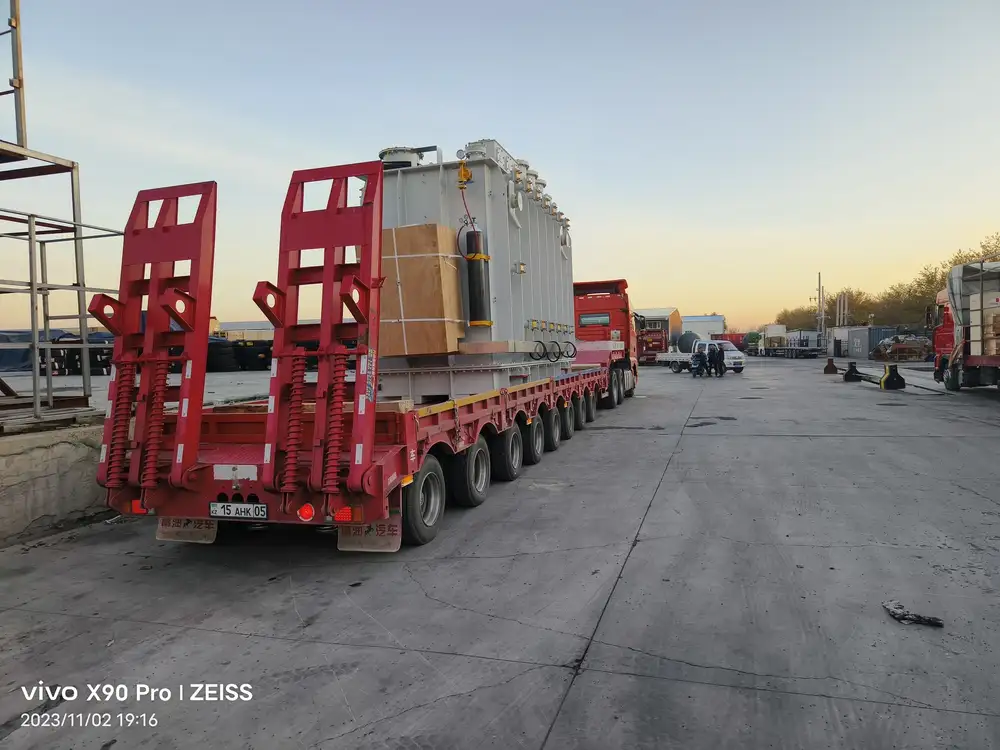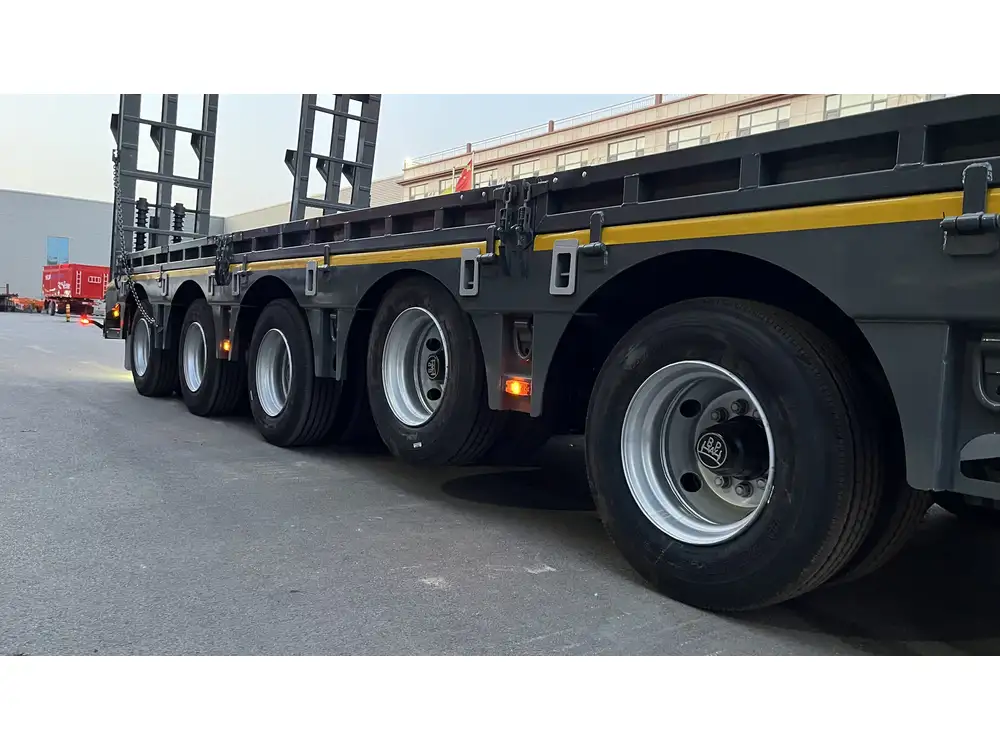What is a Tri-Axle Skeletal Trailer?
A tri-axle skeletal trailer is a specialized type of semi-trailer that is designed primarily for transporting shipping containers. Typically characterized by its lightweight frame and three axles, this trailer configuration helps distribute weight efficiently, paving the way for improved stability and maneuverability. The skeletal design minimizes the trailer’s overall weight while offering a robust structure that can support heavy loads.
Structure and Design Features
| Feature | Description |
|---|---|
| Axle Configuration | Consists of three axles that enhance stability and load distribution |
| Lightweight Frame | Made from high-strength steel, ensuring minimal weight while maximizing strength |
| Container Locks | Equipped with twist locks to secure containers firmly to the trailer |
| Adjustable Width | Many designs offer adjustable width to accommodate various container sizes |
| Tandem Axle Arrangement | Provides greater load-bearing capacity and improves ride quality |
| Tilt Mechanism | Some models feature a tilt mechanism for easier loading and unloading |
The tri-axle design is prevalent among logistics companies and freight carriers due to its versatile application across various types of cargo, especially in maritime shipping where containers are a standard.

Advantages of Tri-Axle Skeletal Trailers
Enhanced Load Capacity
One of the most significant advantages of tri-axle skeletal trailers is their enhanced load capacity. With the distribution of weight across three axles, these trailers can typically carry a higher payload than their two-axle counterparts. This increased capacity is particularly beneficial for businesses that require the transportation of hefty shipping containers, maximizing efficiency and profitability.
Improved Stability and Control
The additional axle promotes better handling attributes. When navigating through tight corners or rough terrains, the tri-axle configuration provides more points of contact with the road, reducing body sway and enhancing overall control. This translates into a safer driving experience, minimizing the risk of accidents and load shifts during transport.

Fuel Efficiency
While it may seem counterintuitive, the lightweight skeletal design, coupled with the tri-axle system, can lead to improved fuel efficiency. By optimizing load distribution, trucks spend less energy on acceleration and maintaining speed, which can lead to significant savings on fuel costs over time.
Versatility in Container Sizes
Tri-axle skeletal trailers are designed to accommodate various container sizes seamlessly. Whether dealing with standard 20-foot containers or larger 40-foot counterparts, these trailers are adjustable and versatile, making them suitable for various shipping needs without requiring multiple trailer types.
Lower Maintenance Costs
Though trailers endure heavy use, the robust design of tri-axle skeletal trailers often results in lower long-term maintenance costs. The durability of high-strength steel frames and advanced engineering mean that they can withstand continuous use and harsh conditions with less frequent repairs, leading to reduced operational expenses.

Common Uses of Tri-Axle Skeletal Trailers
- Intermodal Transport: Ideal for transferring containers between different modes of transport, including ships, trucks, and trains.
- Logistics and Freight Carriers: Widely utilized in the logistics sector for distributing goods in urban and rural environments.
- Construction Materials: Often employed in the transport of prefabricated materials due to their ability to handle hefty weights.
Factors to Consider When Choosing a Tri-Axle Skeletal Trailer
When selecting a tri-axle skeletal trailer for your operations, there are several critical aspects to bear in mind to ensure optimal performance and cost-efficiency:
1. Load Specifications
Understand the load that your operations require. Tri-axle trailers come with varying load capacities; hence, identifying your maximum load is crucial for selecting the correct model.

2. Compatibility with Container Sizes
Select a trailer that is compatible with the types of containers your business frequently transports. Some trailers are designed to handle standard container sizes, while others may have more flexibility.
3. Durability and Materials
Assess the materials used in the construction of the trailer. High-quality steel or aluminum frames are generally more durable and capable of withstanding the wear and tear of heavy loads over time.
4. Features and Add-Ons
Consider any additional features that may benefit your operations, such as air suspension systems for better load management, or tilt mechanisms for easier loading and unloading.

Maintenance Tips for Tri-Axle Skeletal Trailers
Ensuring the longevity and performance of your tri-axle skeletal trailer necessitates diligent maintenance practices. Here’s a detailed checklist for optimal servicing:
| Maintenance Task | Frequency | Purpose |
|---|---|---|
| Tire Inspections | Monthly | To ensure proper inflation and tread wear |
| Brake Checks | Bi-monthly | To maintain stopping efficacy |
| Lubrication of Hubs | Every 5,000 miles | To reduce friction and prevent wear |
| Axle Alignment | Quarterly | To avoid uneven tire wear and enhance handling |
| Visual Inspection | Monthly | To check for signs of structural damage or wear |
Safety Precautions
- Ensure that all container locks are secure before transport.
- Regularly check for hydraulic leaks and address them promptly.
- Maintain an adequate inspection log for compliance and safety audits.
The Future of Tri-Axle Skeletal Trailers

Innovations in Design
The transport industry is transitioning towards embracing more sustainable practices. Manufacturers are now incorporating advanced materials and design techniques aimed at reducing the carbon footprint associated with trailer production and operation.
Innovations such as lightweight composite materials and enhanced aerodynamic shapes are on the horizon. Such advancements not only look to improve fuel efficiency but also empower businesses to meet increasing regulations surrounding emissions and sustainability.
Integration of Technology
The future of tri-axle skeletal trailers is also aligning with technological advancements. Providers are moving towards integrating IoT (Internet of Things) solutions into their trailer systems, allowing for real-time monitoring of cargo, providing alerts for maintenance needs, and enhancing supply chain transparency.
Moreover, GPS tracking is becoming indispensable in logistics, enhancing operational efficiency by allowing companies to accurately track shipments and predict delivery times, which in turn can bolster customer satisfaction.
Conclusion: Maximizing the Use of Tri-Axle Skeletal Trailers
Investing in a tri-axle skeletal trailer can significantly enhance transportation efficiency and operational capability for businesses engaged in freight and logistics. From improved load capacity and control to versatile applications and potential cost savings, the advantages are compelling.
In a competitive market, it is crucial to select the right model based on specific needs, maintain the trailer rigorously, and stay ahead of innovations shaping the industry. Through strategic utilization and proactive management, businesses can maximize the return on investment associated with tri-axle skeletal trailers while delivering superior service to their clients.
By remaining informed and adaptive, your fleet can continue to navigate an ever-evolving landscape and maintain a steady course towards success.



